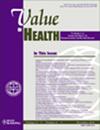针对特定亚群的治疗效果以避免护理效率低下:统计与卫生经济分析之间的冲突。
IF 6
2区 医学
Q1 ECONOMICS
引用次数: 0
摘要
目的:当根据先前确定的异质性将患者分类为亚组时,这种异质性可能会影响卫生干预措施的成本效益。这种异质性在成本效益分析(CEA)中是否被反映或忽略可能会影响报销决策。这是用一种假设的治疗方法来预防疾病进展的模拟研究来说明的。方法:使用DARTH Sick-Sicker Markov模型,我们分析了在1组(G1)和2组(G2)人群中治疗与标准护理的成本-效果。我们比较了通知报销决策的三种策略;1)忽略关于子组差异的证据(“忽略子组证据”);2)对手头试验数据的亚组差异进行检验(“统计指导”),3)对亚组差异使用所有证据(“所有证据”)。该模拟研究改变了总样本量、G2比例、治疗效果和基线死亡风险。对于每种方案,每个策略确定了净健康福利(NHB)和报销决策(即在两个亚组中报销,仅G1组、仅G2组或不报销)。结果:统计引导策略导致除最大总样本量外的亚组被忽略。在获得50,000欧元/QALY的支付意愿阈值时,与忽略亚组证据和合并策略相比,统计指导策略分别导致了-1.00和0.49的NHB增量。结论:当已知亚组异质性时,忽略亚组或采用统计指导方法将导致次优报销决策,从而无法优化社会效益。因此,针对亚组的cea应根据亚组差异的所有可用证据进行评估。本文章由计算机程序翻译,如有差异,请以英文原文为准。
Addressing Subgroup-Specific Treatment Effects to Avoid Inefficient Care: The Conflict Between Statistical and Health Economic Analyses
Objectives
When patients are classified into subgroups based on previously identified heterogeneity, this heterogeneity may affect the cost-effectiveness of health interventions. Whether this heterogeneity is reflected or ignored in cost-effectiveness analysis may influence reimbursement decisions. This is illustrated using a simulation study of a hypothetical treatment to prevent disease progression.
Methods
With the decision analysis in R for technologies in health Sick-Sicker Markov model, we analyzed the cost-effectiveness of Treatment versus standard of care in a population comprising group 1 (G1) and group 2 (G2). We compared 3 strategies for informing reimbursement decisions: (1) ignore evidence on subgroup differences (ignore subgroup evidence), (2) test for subgroup differences in trial data at hand (statistically guided), and (3) use all evidence on subgroup differences (all evidence). This simulation study varied total sample size, G2 proportion, treatment effectiveness, and baseline mortality risk. For each scenario, the net health benefit and reimbursement decision (ie, reimburse in both subgroups, G1 only, G2 only, or no reimbursement) was determined per strategy.
Results
The statistically guided strategy led to subgroups being ignored except for the largest total sample sizes. At a willingness-to-pay threshold of €50 000/quality-adjusted life years gained, the statistically guided strategy resulted in an incremental net health benefit of −1.00 and 0.49 when compared with the strategies of ignoring subgroup evidence and for incorporating, respectively.
Conclusions
When subgroup heterogeneity is known, ignoring subgroups or taking a statistically guided approach will result in suboptimal reimbursement decisions and thus fail to optimize societal benefits. Therefore, subgroup-specific cost-effectiveness analyses should be informed by all available evidence of subgroup differences.
求助全文
通过发布文献求助,成功后即可免费获取论文全文。
去求助
来源期刊

Value in Health
医学-卫生保健
CiteScore
6.90
自引率
6.70%
发文量
3064
审稿时长
3-8 weeks
期刊介绍:
Value in Health contains original research articles for pharmacoeconomics, health economics, and outcomes research (clinical, economic, and patient-reported outcomes/preference-based research), as well as conceptual and health policy articles that provide valuable information for health care decision-makers as well as the research community. As the official journal of ISPOR, Value in Health provides a forum for researchers, as well as health care decision-makers to translate outcomes research into health care decisions.
 求助内容:
求助内容: 应助结果提醒方式:
应助结果提醒方式:


